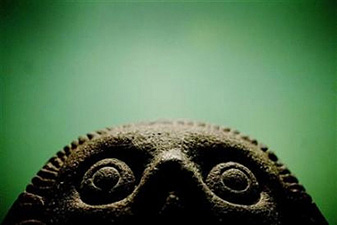
|  |  |  Vallarta Living | Art Talk | September 2008 Vallarta Living | Art Talk | September 2008  
Artifacts Go Back to Mexico
 Stephen Wall - Inland Newspapers Stephen Wall - Inland Newspapers
go to original


| | 2 antiquities dating as far back as 200 B.C. apparently were stolen. | | |
They are two small artifacts, but they make up a big part of modern-day Mexico.

The United States on Thursday formally returned two archaeological pieces, one dating as far back as 200 B.C., to the Mexican government.

Two federal officials turned over the artifacts to Jeremias Guzman Barrera, acting Mexican consul in San Bernardino, during a ceremony at the San Bernardino County Museum.

"These priceless artifacts are beautiful and timeless symbols of Mexico's rich and ancient heritage," Guzman Barrera said.

He said the pieces are symbols of Mexico's indigenous past that was fused with Spanish culture after Hernan Cort s invaded the country in 1519.

"It's who we are, and we are proud of it," Guzman Barrera said.

The two antiquities apparently were stolen from a north central region of Mexico that has been emptied of many ancient artifacts because of an increase in illicit trade, U.S. officials said. Authorities are unsure when they were stolen.

One piece is a black stone mask of a human face dating from between 200 and 750 A.D.

The mask belonged to the indigenous culture of Teotihuacan, where enormous pyramids were built just outside Mexico City.

The other artifact is a ceramic standing figure of a man with a horn.

It is believed to be from the state of Colima in western Mexico and dates from between 200 B.C. and 400 A.D.

Four years ago, an art collector in Denver tried to import the pieces from an art dealer in Paris, France.

When an import specialist from the U.S. Department of Customs and Border Protection in Denver examined the artifacts, he suspected they were from the pre-Columbian period.

The official contacted an assistant professor of anthropology at the University of Colorado, who verified that the pieces were authentic pre-Columbian artifacts from Mexico.

The person who imported the items into the United States was unable to prove they were legally taken from Mexico.

If the importer lacks the required license, the art can be seized.

The artifacts were administratively forfeited to the U.S. government in the spring.

Until Thursday, the artifacts were kept in a federal warehouse in Riverside where seized items are stored.

The items will be flown to Mexico City next week. The artifacts likely will become part of the collection at the National Anthropology Museum in Mexico City, Guzman Barrera said.

stephen.wall(at)inlandnewspapers.com |

 |
|  |



